Files in this item
NetFACS : using network science to understand facial communication systems
Item metadata
| dc.contributor.author | Mielke, Alexander | |
| dc.contributor.author | Waller, Bridget M. | |
| dc.contributor.author | Pérez, Claire | |
| dc.contributor.author | Rincon, Alan V. | |
| dc.contributor.author | Duboscq, Julie | |
| dc.contributor.author | Micheletta, Jérôme | |
| dc.date.accessioned | 2021-11-16T10:30:01Z | |
| dc.date.available | 2021-11-16T10:30:01Z | |
| dc.date.issued | 2021-11-09 | |
| dc.identifier | 276647494 | |
| dc.identifier | 91efbea4-e6df-4847-ad6f-932fabfc33fd | |
| dc.identifier | 85118634074 | |
| dc.identifier.citation | Mielke , A , Waller , B M , Pérez , C , Rincon , A V , Duboscq , J & Micheletta , J 2021 , ' NetFACS : using network science to understand facial communication systems ' , Behavior Research Methods , vol. First Online . https://doi.org/10.3758/s13428-021-01692-5 | en |
| dc.identifier.issn | 1554-3528 | |
| dc.identifier.other | RIS: urn:C4D28F2164974EE261DFF0A877CE4951 | |
| dc.identifier.other | RIS: Mielke2021 | |
| dc.identifier.uri | https://hdl.handle.net/10023/24339 | |
| dc.description | The NetFACS project is funded by a Leverhulme Trust Research Project Grant. AM received funding from the British Academy Newton International Fellowship scheme. | en |
| dc.description.abstract | Understanding facial signals in humans and other species is crucial for understanding the evolution, complexity, and function of the face as a communication tool. The Facial Action Coding System (FACS) enables researchers to measure facial movements accurately, but we currently lack tools to reliably analyse data and efficiently communicate results. Network analysis can provide a way to use the information encoded in FACS datasets: by treating individual AUs (the smallest units of facial movements) as nodes in a network and their co-occurrence as connections, we can analyse and visualise differences in the use of combinations of AUs in different conditions. Here, we present ‘NetFACS’, a statistical package that uses occurrence probabilities and resampling methods to answer questions about the use of AUs, AU combinations, and the facial communication system as a whole in humans and non-human animals. Using highly stereotyped facial signals as an example, we illustrate some of the current functionalities of NetFACS. We show that very few AUs are specific to certain stereotypical contexts; that AUs are not used independently from each other; that graph-level properties of stereotypical signals differ; and that clusters of AUs allow us to reconstruct facial signals, even when blind to the underlying conditions. The flexibility and widespread use of network analysis allows us to move away from studying facial signals as stereotyped expressions, and towards a dynamic and differentiated approach to facial communication. | |
| dc.format.extent | 16 | |
| dc.format.extent | 2169034 | |
| dc.language.iso | eng | |
| dc.relation.ispartof | Behavior Research Methods | en |
| dc.subject | Facial action coding system | en |
| dc.subject | Facial signals | en |
| dc.subject | Network analysis | en |
| dc.subject | Communication | en |
| dc.subject | BF Psychology | en |
| dc.subject | DAS | en |
| dc.subject.lcc | BF | en |
| dc.title | NetFACS : using network science to understand facial communication systems | en |
| dc.type | Journal article | en |
| dc.contributor.institution | University of St Andrews. School of Psychology and Neuroscience | en |
| dc.identifier.doi | https://doi.org/10.3758/s13428-021-01692-5 | |
| dc.description.status | Peer reviewed | en |
This item appears in the following Collection(s)
Items in the St Andrews Research Repository are protected by copyright, with all rights reserved, unless otherwise indicated.

